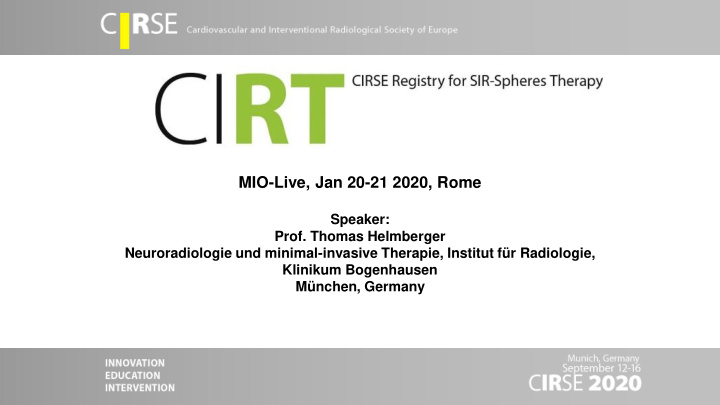



MIO-Live, Jan 20-21 2020, Rome Speaker: Prof. Thomas Helmberger Neuroradiologie und minimal-invasive Therapie, Institut für Radiologie, Klinikum Bogenhausen München, Germany
Study objectives Primary end point The primary objective is to observe the real-life clinical application of SIRT with SIRT Y-90 resin microspheres and the impact of the treatment in clinical practice. This will be categorized as one of the following 5 categories with sub-categories: 1. Type of liver cancer (primary or secondary/metastatic) 2. Intention of treatment (bridging, down-sizing, palliative or ablation) 3. Prior hepatic procedures (surgical, ablative, vascular and abdominal) 4. Associated systemic therapy (prior- and post-SIRT systemic therapy and concomitant chemotherapy) 5. Post-SIRT hepatic procedures (surgical, ablative, vascular and abdominal)
Study objectives Secondary end points Effectiveness Overall survival Progression-free survival Hepatic progression-free survival Imaging response Safety Treatment complications Adverse events Laboratory assessments Technical considerations Patient-related characteristics Treatment planning Treatment administration Procedure-related outcomes Quality of life QLQ-C30 with HCC Module (if HCC)
Enrolment figures 1200 1047 1000 800 782 600 688 588 400 491 371 269 200 214 141 98 0 48 22 1
Patient distribution per country • 8 countries • 27 hospitals • 1047 patients Country Hospitals Patients Belgium 4 100 France 1 58 Germany 12 424 Israel 1 14 Italy 5 176 Spain 1 32 Switzerland 1 120 Turkey 2 123
How did we get there: baseline Status quo in 2013 • BSIR SIRT registry in the UK just started with patient enrolment • Commissioned by the National Institute for Health and Care Excellence (NICE) as a service evaluation of the use of SIRT in routine care in the UK • Already enrolling patients • Ready-to-go electronic data capturing system (EDC) and case report form (CRF) • CIRSE could adopt and adapt this system to its own needs • SIRTEX was the clear market leader in radioembolisation at the time and an observational study on SIR-Spheres would reflect well how radioembolisation is performed in Europe, thus justifying a single device study • No large data sets existed on the clinical application of SIRT in Europe
How did we get there: the first steps Original purpose of the study Exploratory • No large-scale body of evidence existed on how SIRT was performed in European clinics • Possibilities to find potential relationships between indications, treatment modalities and outcomes Inclusive • All indications • As many countries as possible • As much data as feasible First CIRT objective “The objective of CIRT is to prospectively capture as broad a spectrum of data as feasible, with the aim of understanding the real-life application of radioembolisation with SIR-Spheres microspheres. Due to the observational nature of CIRT the investigators decided not to predefine detailed research questions and therefore specific endpoints” (CIRT Protocol, 27 October 2014)
Progression to maturity: a critical evaluation • CIRT actually started to be more successful than anticipated • More hospitals interested than expected • Progressive patient enrolment • Realisation that CIRT data has a lot of value and potential • Refining the science: • Coming to a concrete definition of “real - life application” • Review and refine the CRF to ensure all data is captured and objectives are met • Concrete measurements for safety, effectiveness and quality of life • Develop a statistical analysis plan with an independent statistician • Rethinking the research infrastructure – ensuring quality control
Developing the research infrastructure CIRSE Study SOPs • Defining clear SOPs for • Site invitations and contracting • Remote monitoring and data quality control EDC • Critically evaluate the electronic data capturing (EDC) system against industry standards • No reliance on third-party programming, ability to modify data points when needed • Ability to control levels of authorisation (CIRT can only include PIs. PIs responsible for including local users) • Direct site interaction through EDC interface Learn to evaluate local resources and qualifications • Not all sites have a study centre or study nurses • Rely on information from sites instead of industry regarding treatment volume
CIRT: summary Strengths Points for development Solutions • • • Large data sample (+1000) Poorly defined objectives at the Objectives reworked throughout • Inclusive (all indications) beginning of the study the study • • • 150+ data points per patient and Poor understanding of site Qualification questionnaire for high data completion infrastructure and needs site initiation • • • Many publications and congress Poor EDC Now OpenClinica for future • presentations possible No system for quality control studies • • • Multidisciplinary Steering One IR chairperson, missing the CIRSE Quality System • Committee perspective of other relevant Dual Chairpersonship, disciplines for day-to-day multidisciplinary decision-making
Implementing lessons learned: CIRT-FR Reimbursement study • Commissioned by the French national health authorities (HAS) to evaluate the clinical application and outcomes from SIR-Spheres following approval of reimbursement for patients with mCRC in March 2017 • Working to external standards: reviewed and approved by French governmental institutions (HAS, CNIL, CDEDiMTS) • Using the verified primary and secondary end points from CIRT • Proof of concept that CIRSE can successfully initiate and conduct reimbursement studies
Implementing lessons learned: CIRT-FR Patient enrolment: August 2017 – January 2020 (n=219) Improvements compared to CIRT 250 • Well-defined objectives and CRF 203 218 219 • 200 Full deployment of CIRSE Quality System 184 for data monitoring 175 150 147 • Involvement of study nurses and study 127 109 centres from the beginning 100 97 84 • Inclusion of case logs to understand 75 59 50 patient representation (96%) 41 • 21 Dual chairpersonship: Prof. Thomas 7 0 1 Helmberger and Prof. Valérie Vilgrain
Thank you! CIRT & CIRT-FR Steering Committee CIRSE 2019
Recommend
More recommend